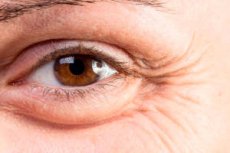New publications
Skin wrinkles as we age, and that's why wrinkles appear, study finds
Last reviewed: 27.07.2025

All iLive content is medically reviewed or fact checked to ensure as much factual accuracy as possible.
We have strict sourcing guidelines and only link to reputable media sites, academic research institutions and, whenever possible, medically peer reviewed studies. Note that the numbers in parentheses ([1], [2], etc.) are clickable links to these studies.
If you feel that any of our content is inaccurate, out-of-date, or otherwise questionable, please select it and press Ctrl + Enter.

Aging skin stretches, contracts and "puckers" under pressure - that's how wrinkles form, according to new experimental data from scientists at Binghamton University (State University of New York).
By studying human skin samples, a research team led by biomedical engineering associate professor Guy German found that older people's skin is more prone to wrinkles. Why? Wrinkles form when skin is stretched in one direction and compressed in another, causing it to "wrinkle" — an effect that becomes more pronounced with age.
"This is no longer just a theory," German said. "We now have solid experimental evidence of the physical mechanism underlying aging."
Scientists have long suspected that skin ages and wrinkles due to a variety of factors (such as genetics, medical conditions, and sun damage). Previous studies using computer models have shown that the dermal layer of skin (which contains collagen and elastin and provides structural support) experiences age-related changes in mechanical properties and structure. But until now, these assumptions have not been confirmed experimentally with real skin samples.
This research, German says, is one of his “lifelong goals” and a kind of “holy grail” of skin mechanics. The cosmetics industry offers a huge number of anti-aging products, and it can often be difficult to figure out what actually works.
“When I started working in this field, I set out to understand the mechanism of aging,” says German. “Because when I turn on the TV, the radio, surf the Internet, or go to the store, I’m offered a thousand different ways to improve the health of my skin. And I wanted to understand what was true and what wasn’t. So I decided to cut to the chase and figure it out myself.”
German, along with former students Abraham Ittyheri and Alejandro Wiltshire, used a low-load strain gauge to stretch tiny strips of skin from people aged 16 to 91, simulating the forces skin experiences in everyday life. They found that when skin is stretched in one direction, it contracts in the perpendicular direction. But as people age, this contraction increases, leading to wrinkles.
"If you stretch a 'sticky mass' like play dough, for example, it gets longer horizontally but thinner vertically. The same thing happens with skin," German explained. "As we age, this compression becomes greater. If the skin is compressed too much, it begins to wrinkle. That's how wrinkles appear."
Young skin has certain mechanical properties, but as we age, things start to "go wrong," he added:
"Over time, the structure degrades, the skin stretches more to the sides, and this causes wrinkles to form. The reason is that the skin is not initially in a state of complete rest: it has internal tensions, and these become the driving force behind the appearance of wrinkles."
As summer approaches, German reminded us that premature aging of the skin from prolonged sun exposure has the same effect on the skin as chronological aging:
"If you spend your whole life working outside, your skin will likely be older and wrinkled than that of an office worker. Chronological aging and photoaging produce similar results. So enjoy the summer, but don't forget the sunscreen - your future self will thank you."
The study, titled “Elucidating the Mechanistic Process of Age-Induced Human Skin Wrinkling,” is published in the Journal of the Mechanical Behavior of Biomedical Materials.
